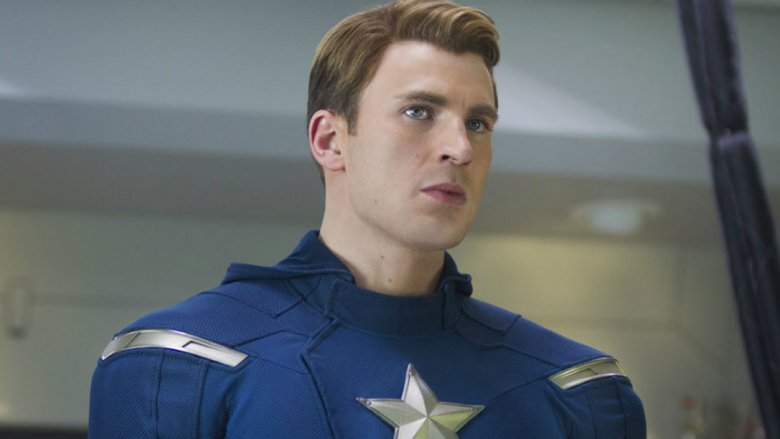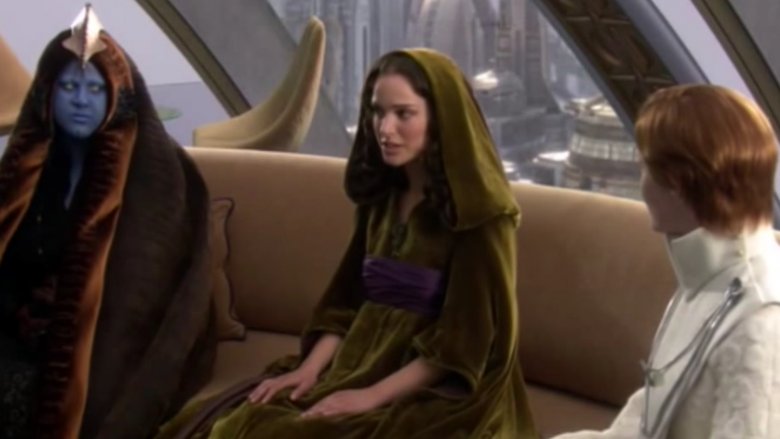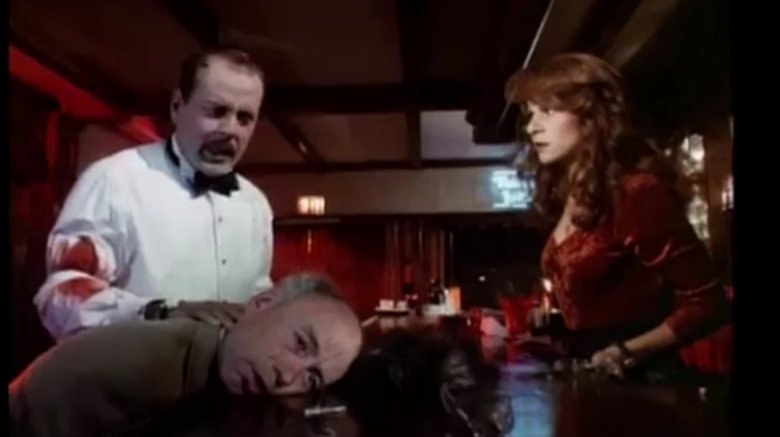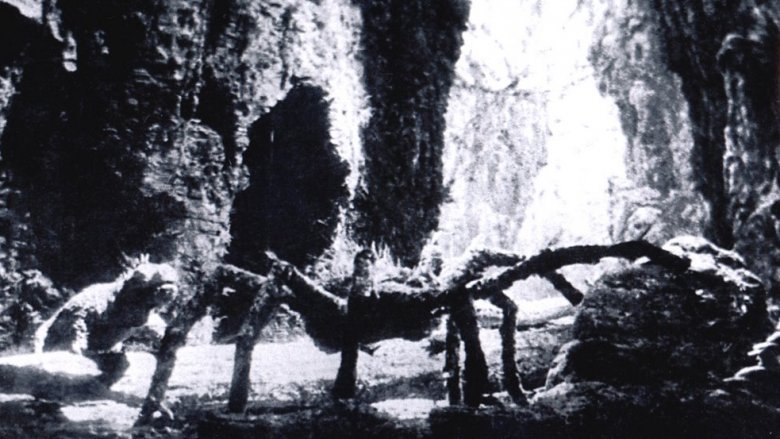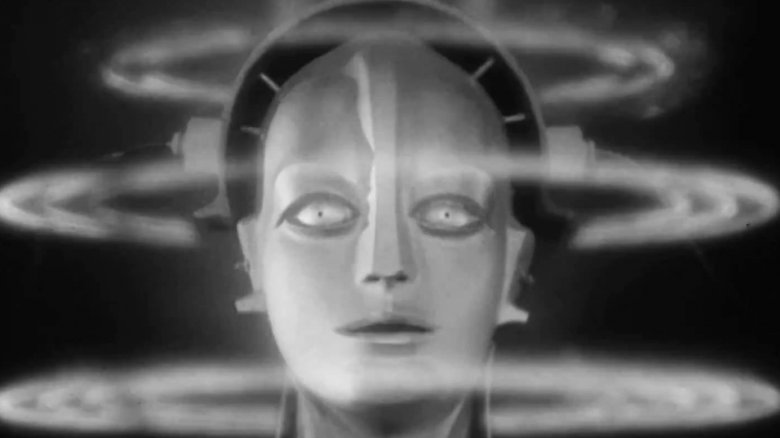Scenes That Were Deleted From Films For Dumb Reasons
Filmmaking is a complex process with an overwhelming number of moving parts, and every major motion picture is the result of hundreds of artists working together to tell a cohesive story. Even with strong leadership from directors, writers, and department heads, differences in vision are bound to happen.
Often, things just don't work out onscreen like they do on the page. Add to this the business side of show business, with studio executives always second-guessing how to make their product most profitable, and you end up with a pretty vast graveyard of footage that should never have been lost. With that in mind, here's a fond look back at some deleted scenes that ended up on the cutting room floor for dumb reasons we still don't understand.
Little Shop's lost ending
Test screenings have lost some of their power now that anyone can spoil everything about a movie before even leaving the theater. There was a time, however, when audiences granted access to an unfinished cut of a film wielded massive influence over its fate, and the most tragic victim might be Little Shop of Horrors.
This 1986 cult classic, helmed by acclaimed director Frank Oz, adapted Howard Ashman and Alan Menken's musical — which was itself based on a low-budget B-movie by Roger Corman. The stage show ended like a true morality play, having hero Seymour's Faustian bargain with a man-eating plant lead to his own downfall, the loss of his beloved Audrey, and finally civilization itself. A rollicking musical number reminded the audience of the story's moral, the cast came back for a final bow, and a silly night of song and dance was had by all.
A test screening quickly taught Oz a lesson in the differences between stage and screen. "In a movie, the character does not come back for a bow. That character is dead," he would later reflect. The audience had grown attached to the characters and hated seeing them die — and light of their negative reaction, Oz and Ashman knew they had to quickly come up with a happier ending.
The result is arguably more crowd-pleasing, but doesn't really follow through with the story's themes. Seymour (Rick Moranis) never faces any comeuppance, and the plant is rapidly defeated. Plus, a showcase of stunning puppet effects was left on the cutting room floor, seemingly never to be seen again. That is, until 2012, when an Oz-sanctioned "Director's Cut" debuted at the New York Film Festival to enthusiastic applause. The intended ending in its finished form is so big, bright, and raucous that the early hesitance seems to have been unfounded after all.
The Muppet Christmas Carol, 'When Love Is Gone'
The Muppet Christmas Carol was something of a miracle at the time of its release in 1992. As the first major Muppet production after the death of Jim Henson two years earlier, it was a film with a lot to prove. Under the direction of Henson's son Brian, Christmas Carol not only became an instant holiday classic, it proved that the heart of the Muppets could beat on even without the man who started it all — but that heart was compromised by studio interference in the version audiences first saw.
One of the film's most important emotional turning points was to be the song "When Love Is Gone," sung by Belle (Meredith Braun) to a young Scrooge (Raymond Coulthard) as the older Scrooge (Michael Caine) looks on. Caine's performance in the moment when Scrooge tries to sing along before being overcome with emotion is heartbreaking, and pays off beautifully with a triumphant reprise at the very end of the film. But, as Braun later recalled, Disney executives removed the entire song, worried it was too slow for children. Henson and Disney reached a compromise that had the song restored to the VHS, but every release since is still missing the sequence, save for the cropped "pan-and-scan" version on DVD.
Star Wars prequels' vanishing Padmé
Debate over the pros and cons of the Star Wars prequels will rage on as long as there's an internet. Especially frustrating, though, are the places where the movies were so close to being better than what we got. The biggest example of this is probably the cuts made to the character of Padmé, starting with a major sequence in Attack of the Clones.
George Lucas shot several scenes of Padmé visiting her parents (Trisha Noble and Graeme Blundell) while under the protection of Anakin Skywalker (Hayden Christensen). Their discussions about the threat on Padmé's life, as well as a scene in which Anakin views holographic recordings of her activism efforts, would have explained what Padmé had been doing in the decade since the events of The Phantom Menace.
The issue continued with Revenge of the Sith, which initially included an entire subplot in which Padmé discusses her concerns about the state of the galaxy with senators Bail Organa (Jimmy Smits) and Mon Mothma (Genevieve O'Reilly). Eventually, the trio formally found the Rebel Alliance with a small band of politicians. All of these scenes were scrapped, leaving Padmé with little to do in Episode III besides get pregnant, worry about Anakin, and eventually die because she literally gives up the will to live. The Padmé-centric material in both Clones and Sith fell victim to Lucas' efforts to streamline the story and focus on Anakin, but spending more time with the soon-to-be Darth Vader at the expense of a heroic female lead does nothing to help the shallow character work for which the trilogy is often criticized.
Batman Forever's cave crisis
After critics and parents complained in droves about Batman Returns and its cocktail of dark visuals and psychosexual themes, executives at Warner Bros. were determined to rebrand their star superhero franchise as more family-friendly fun. They hired director Joel Schumacher, who delivered Batman Forever, a slick, bright adventure aimed directly at the MTV generation. Forever still had a psychological core in its arc of Bruce Wayne (Val Kilmer) grappling with his lingering guilt over his parents' death. Even this, though, fell victim to a desire to be the opposite of Returns.
Throughout the film, Bruce recounts his recurring nightmares about his father's journal and its final entry. His turmoil over his own motivations becomes so great he even shuts down the Batcave and declares that he will no longer be Batman. In the climactic showdown with Two-Face and the Riddler, he reclaims the cowl mostly out of necessity, leaving his character arc largely unresolved. However, there was originally to be a scene in which he ventures into a deeper, unexplored part of the cave, where he finds his father's real journal and communes with a vision of a man-sized bat creature. Reaffirmed in his calling and free from misplaced guilt, he returns to the surface and declares himself Batman once more.
The studio excised the moment, along with numerous other cerebral or potentially frightening scenes, in their effort to make Forever as unlike Returns as possible, limiting the surreal puppet work to a fleeting glance and leaving the film with half-finished ideas and a title that makes less sense than it should.
The Shining's European cut
Most of Stanley Kubrick's films have undergone critical reappraisals after underwhelming releases — perhaps none more extreme than The Shining. Upon its initial release in the United States, many critics panned it, it flopped at the box office, and was dubiously honored by the very first Razzie awards. As a reaction to the negativity, Kubrick decided to cut 24 minutes from the film for its release in Europe. As detailed by Movie-Censorship.com, out went expository scenes about the marriage of Jack (Jack Nicholson) and Wendy Torrance (Shelly Duvall), their son Danny's (Danny Lloyd) history of visions, and the dark past of the Overlook Hotel. Kubrick also trimmed out moments of the family's daily life and several of the long hallway tracking shots.
While it's true that most of the lost scenes seem, on the surface, to either repeat information or add nothing to the plot, deeming them unnecessary indicates a misunderstanding of what makes The Shining work. Jack's abusive past lingers over the family, the hotel's privileged past patrons give the film its social themes, and the empty moments bring a hypnotic sense of isolation to the experience. Though Kubrick made the cuts himself and approved of both versions, his deviations from his original instincts left European audiences with a film lacking the very qualities that would later bring critics to hail it as a horror masterpiece.
The Avengers' lonely Cap
Joss Whedon's industry-changing Marvel mash-up The Avengers made obscene amounts of money for good reason. While its artistic merits could be debated, there's no denying that Whedon and his team pulled off an impressive balancing act, bringing together a massive cast of main characters into a guaranteed crowd-pleaser. It does, however, tend to keep Tony Stark (Robert Downey Jr.) front and center. It's a choice that makes sense — the Iron Man films had the biggest cultural footprint of Marvel's first phase and the character is well-suited for Whedon's trademark one-liners — but one that robbed some of Downey's co-stars of potential screentime.
At one point in its development, The Avengers had a more even-handed focus. A lengthy sequence would have introduced Steve Rogers (Chris Evans) with more emphasis on his efforts to adjust to the 21st century. After wistfully looking through the files of his old friends and failing to work up the nerve to call Peggy Carter (Hayley Atwell), he'd walk to a nearby café to clear his head with some sketching, chatting with a waitress (Ashley Johnson) about how many of her customers come to catch a glimpse of Iron Man (Stan Lee, making an early MCU cameo, would have encouraged Steve to get her number).
The waitress gets special attention in the final cut when she's saved by Captain America in the climactic battle — something that loses a little of its impact since the audience doesn't know her. In an interview with Vulture, Whedon explained that he cut this entire introduction to tighten the first act, but with the amount of time the movie still spends on Stark, that hardly seems fair.
The Black Cauldron's villagers and violence
The Black Cauldron is among the least-remembered of Disney's animated classics. Stuck between the studio's formulaic-but-entertaining '70s fare and the masterworks of their late '80s renaissance and beyond, its place in history is a side effect of creative growing pains. Its creation was so troubled that producer Don Hahn would later assemble the documentary Waking Sleeping Beauty to reflect on it as a dark point in Disney history.
Based on Lloyd Alexander's Chronicles of Pyrdain fantasy novels, the film spent nearly 15 years in development, eventually becoming Disney's most expensive feature to that point. As it finally neared completion, massive executive changeover occurred, with Michael Eisner taking the role of Disney CEO and placing Jeffrey Katzenberg in charge of film production. Katzenberg had no direct experience with animation, and immediately clashed with the Cauldron team, as animator Michael Peraza Jr. would later recall on his blog.
In the pre-computer days of ink and paint, changes were rarely made in animation after the storyboard phase, due to the extreme labor and expense of every finished scene. When the crew refused to take Katzenberg's notes on how The Black Cauldron could be improved at such a late stage, he personally took the film reels to an editing bay and removed scenes by hand, tightening up the pace by removing exposition and toning down potentially frightening scenes by cutting gruesome shots from the zombie-filled climax.
While Black Cauldron was almost certainly doomed to box office failure before these changes, this creative battle of wills likely didn't help the muddled plot and lackluster action of the final product. Katzenberg went on to make peace with the animation division and lead them to unprecedented success, but The Black Cauldron was left to linger in the bottom tier of the studio's illustrious catalog.
Death Becomes Her's missing friend
Director Robert Zemeckis could do no wrong in the late '80s and early '90s. Romancing the Stone, Who Framed Roger Rabbit, and the Back to the Future trilogy were all instant classics, and Forrest Gump was just ahead. In the midst of these successes, though, came the oddity Death Becomes Her. Box office totals show that it wasn't a financial failure, but Death received mixed reviews and has gained a much smaller cult following than Zemeckis' other hits. Despite a stellar leading trio of Meryl Streep and Goldie Hawn as rivals who take an eternal youth potion and Bruce Willis as the henpecked plastic surgeon caught between them, the film fell victim to a troubled editing process.
Initially, Ernest (Willis) had a friend in a bartender named Toni (Tracey Ullman), with whom he frequently discussed his problems. As Ullman would later detail on her blog, the film was to end with Toni helping Ernest fake his own death to escape the war between his undead exes Madeline (Streep) and Helen (Hawn). An epilogue scene depicted Ernest and Toni living happily as an elderly couple while a youthful but bitter Madeline and Helen look on. According to Ullman, a test audience found this ending too sweet, and it was replaced with a snarkier conclusion in which Madeline and Helen attend Ernest's funeral while their reanimated bodies crumble. This change required the removal of all of Ullman's scenes, robbing the movie of not only a dose of heart, but its only female character who didn't sell her soul in a vain grasp at beauty.
King Kong's spider pit
In 1933, the original King Kong revolutionized special effects with a leading monster who roared, rampaged, and even fell in love. The climactic Empire State Building climb would become its most iconic moment, but the film's first real thrills come in an adventure through a jungle crawling with prehistoric creatures. Generations of filmmakers have cited Kong's battling beasts as an inspiration, but there were some that few people ever got to see — such as the sequence in which a group of sailors, seen in the final cut tumbling into a ravine, find themselves in a nest of giant arachnids and other horrific insectoids.
As chronicled by Hollywood historian Martin Grams, director Merian C. Cooper, something of a larger-than-life adventurer himself, would later offer opposing stories of the scene's removal in various interviews, sometimes claiming a test audience was too frightened to stand it, and other times stating that he cut it during production because it slowed down the story. Whether the scene was too effective or the monster action held up a plot that mainly existed to show off monster action, neither rationale seems strong enough to cut it. All the "Spider Pit" footage was lost, but the sequence became so legendary that Peter Jackson recreated it using original script pages and puppet designs as a side project while remaking Kong in 2005.
Metropolis, Heart and Hel
There are plenty of reasons that movies have lost scenes that never should have been cut, but few films have ever been so damaged by misguided thinking as Fritz Lang's silent science fiction landmark Metropolis. An epic fable about downtrodden workers in a futuristic city rising up against the wealthy capitalist ruling class, it debuted in 1927 at a sprawling two and a half hours. In America as well as its native Germany, Metropolis was subjected to extreme cuts — not only for length, but for its perceived communist themes, as detailed by Fernando Martín Peña of the International Federation of Film Critics. Silliest of all, the entire motivation for scientist Rotwang (Rudolf Klein-Rogge) to build a robot was removed because the name of his lost love, Hel, was deemed by American censors to be too similar to the word "hell."
By the mid-20th century, nearly a quarter of Metropolis' original content was lost and seemingly destroyed as it fell into the public domain. Though it maintained a reputation as an important piece of cinema history, film scholars were left to pick over script pages in an effort to understand what might have been. That all changed in 2008, when the curator of the Museo del Cine in Buenos Aires discovered a bootlegged print of the premiere cut uncatalogued in the museum's archives. Finally, Metropolis was restored to its status as a stunning example of early sci-fi — and a significant piece of pre-Nazi German art.
